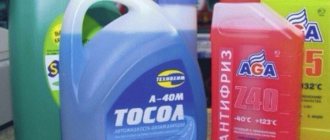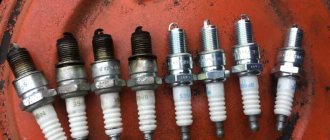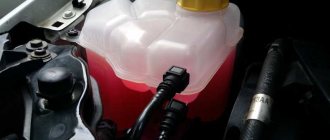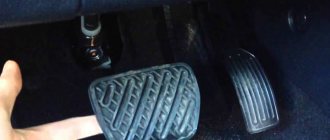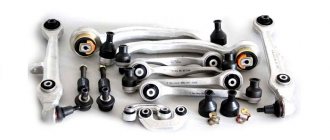Here are some signs indicating that it is time to replace the antifreeze in your VAZ 2107. These include:
- Frequent overheating , constant operation of the cooling fan, and steam emanating from the radiator may indicate a breakdown in the cooling system or excessive contamination of the antifreeze. Such situations most often occur in the summer, but sometimes they can occur in the winter.
- The appearance of an unpleasant odor in the radiator or expansion tank. In normal condition, the coolant has no odor; its appearance is a signal of the need for urgent replacement.
- A significant change in the color of antifreeze and its thickening indicate the presence of a large amount of pollutants.
The presence of one or more of the described signs indicates that it is time to change the coolant.
Replacement frequency and what antifreeze to fill
The volume of the cooling system in the VAZ-2107 is 9.85 l . Standard antifreeze, which most car enthusiasts use, needs to be replaced every 2 years or after 60 thousand km. Please note that some other brands have different recommendations. Be sure to read all accompanying information.
- If your car was manufactured before 1998 , you can use regular antifreeze or class G .
- For cars manufactured from 1998 to 2002, regular antifreeze and class G .
- Cars manufactured from 2003 to 2012 G12+ or G12++ class coolants
Signs of aging antifreeze
Antifreeze, like any other working fluid in a car, has its own resource. To determine that antifreeze needs to be replaced, you need to understand what signs indicate this.
Firstly, you should pay attention to the temperature conditions of the engine. If the power unit is constantly overheating, the cooling fan is constantly running, the coolant temperature needle is in the red zone, and steam is coming from the radiator - you must first check the condition of the cooling system and the antifreeze itself. In the case of the “seven”, such problems usually arise in the warm season, and in worst cases, in winter.
Secondly, the produced antifreeze has an unpleasant odor. You can smell it from the radiator or expansion tank. It should be understood that if the coolant begins to smell, then all permissible periods for its replacement have already passed. It is possible that in this case it may be necessary to repair some elements of the cooling system.
The third thing you need to look at is the color and consistency of the antifreeze. Slight darkening of the coolant is not a sign of a necessary replacement, but a strong change in color and thick consistency of the antifreeze indicates that a large amount of contaminants has accumulated in it.
If one or more of the described symptoms is present, the coolant must be replaced immediately, regardless of whether it is fresh or not.
What is needed to replace antifreeze?
To carry out the operation, you need to prepare all the instruments . But first of all, choose a convenient place to work. An overpass or pit should be considered optimal. In this case, you need to choose the location so that the front of the car is slightly higher than the rear.
You need to stock up:
- A set of keys.
- A container for draining old fluid.
- Fresh antifreeze (10 liters).
- A special product with which we will remove dirt from plugs, bolts and other parts.
- Flat and figured screwdriver.
- Hose for the drain hole.
- A funnel with which we will fill in the new liquid.
How to fill in new coolant
VAZ instructors recommend using AM and A40M antifreeze for models 2109. In the event that it is impossible to use an inspection hole, as an option, the car owner can be advised to purchase special taps that are installed instead of drain plugs. A hose is attached to these taps, and the liquid already circulates through it. This device greatly simplifies the process of replacing coolant.
Work on replacing antifreeze is carried out only on a cold engine.
So, to fill in antifreeze, you need to do the following:
- First, you need to tighten the drain plug located on the radiator. You also need to remove the plug from the cylinder block. We untie the clamp of the antifreeze outlet hose and disconnect it from the throttle fitting. Then you need to hold this hose with your hand. We fill the new antifreeze into the tank. You need to fill in about four to five liters. Return the hose to the fitting. Tighten the clamp on the hose. Again you need to fill the antifreeze into the expansion tank. You need to pour until the liquid reaches the maximum mark. In total, about seven to eight liters of antifreeze should be spent. Next, you should replace the tank cap. Then return the ignition module. You should start the car and warm up the engine to operating condition. Next, turn off the engine and again you need to measure the antifreeze level. If the coolant level does not reach maximum mark, then you need to add more antifreeze
When pouring antifreeze, several important points should be taken into account:
- As already mentioned, all work should be carried out exclusively with a cooled engine. When draining the coolant, there is a risk of moisture getting on the generator. To prevent this from happening, it is necessary to protect the generator before draining. Be sure to check the antifreeze level after running the engine. If the fluid is below the maximum mark, then over time the engine will begin to overheat, which can accelerate the process of wear and tear. It is not recommended to allow antifreeze and antifreeze to mix. Liquids differ in composition, so the quality of their work when mixed will be significantly reduced
The engine cooling system is an important part of every car, through which the normal operation of the engine is ensured. A significant part of the cooling system is devoted to refrigerant or coolant, which can be presented in the form of antifreeze (in most cases), antifreeze or distilled water. During the operation of any car, including the VAZ 2107, it is important to promptly replace the coolant, which will improve the efficiency of the cooling system. In this issue, we will look in more detail at how to correctly replace antifreeze on a VAZ 2107, what is required for this and where to start.
Replacing antifreeze in a VAZ-2107
Wait until cools down completely . Antifreeze is a toxic substance, so it is better to carry out work in a well-ventilated area or in the open air. Follow basic safety rules when working with toxic substances.
Draining old antifreeze
First of all, remove the engine crankcase protection, if any. In many cases, the bolts are in a rusty state and are therefore quite fragile. This requires care when dismantling. It is best to use special tools that facilitate the process of freeing soured bolts. Among such products are, for example, WD-40 or EFELE UNI-M Spray. After this, in the cabin we move the heater control lever to the maximum position. In this case, there is no need to start the heater.
Next, open the filler neck of the radiator and expansion tank. This operation will allow you to drain the old antifreeze much faster. Further actions depend on the radiator model. The original radiators of the latest models have a special tap . Please note that it is susceptible to souring, so it may require special treatment.
Radiators of older models require unscrewing the fan switch off sensor (it is located on the inside) or disconnecting the hose, which is located on the lower pipe. Next, remove liquid from the internal circuit of the cooling system. The drain plug looks identical to the 13 bolt; you need to unscrew it and drain all the liquid through the hose that you prudently stocked up on.
We release the expansion tank by unfastening the fastening belt and lifting the container 30–40 centimeters up. This simple method stimulates the flow of liquid into the radiator and then into the prepared container.
Flushing the cooling system
This stage is not always . But in some cases it is simply necessary. For example, if you decide to change the brand of antifreeze and your choice does not match the chemical composition with the previous decision. Flushing is also necessary in cases where there are significant contaminants or plugs that impair engine performance. It is recommended to carry out this operation even when your car is a new purchase (especially if you bought a used car). Don't forget about the expansion tank . All hoses are removed from it, it is separated from the fastenings, and then thoroughly washed from the inside.
Adding fresh antifreeze
The last stage of the entire operation is pouring fresh fluid . First of all, disconnect the hose from the intake manifold fitting, which is located under the carburetor. If the car is equipped with an injection engine, it is necessary to disconnect the receiver heating hose. This will prevent air pockets from occurring. The hoses are secured with clamps, so the work requires the use of a screwdriver. After this, new coolant is poured into the expansion tank. The liquid level should be approximately 3–4 centimeters above . After the operation is successfully completed, you will be able to notice that antifreeze is flowing out of the previously opened hole on the intake manifold or receiver. Immediately after this, put the hose in place and tighten it with a clamp.
Lack of fluid and consequences
The disadvantage of antifreeze is rapid evaporation; you also have to solve the problem of leakage. It happens that liquid can be seen leaking under the car. There are also cases when it goes into the car interior, this indicates a breakdown of the heater taps, they need to be replaced.
In addition, smoke may be emitted from the exhaust pipe. This occurs due to a faulty cylinder head gasket. When antifreeze boils, you need to fix the problem in time ; you need to drain it and change it.
If you do not give significance to the signs that appear and continue to move on, then the consequences can be very sad. If the fluid disappears from the tank, the motor may overheat when the mark reaches the minimum value.
Video
The engine cooling system is an important part of every car, through which the normal operation of the engine is ensured. A significant part of the cooling system is devoted to refrigerant or coolant, which can be presented in the form of antifreeze (in most cases), antifreeze or distilled water. During the operation of any car, including the VAZ 2107, it is important to promptly replace the coolant, which will improve the efficiency of the cooling system. In this issue, we will look in more detail at how to correctly replace antifreeze on a VAZ 2107, what is required for this and where to start.
Are there any differences between an 8- and 16-valve engine?
As you know, the first “ten” models were equipped with engines of an old design with an 8-valve timing mechanism. In the early 2000s, the famous “shesnar” appeared in the lineup, which car owners loved so much for its high power and efficiency. This timing mechanism has its pros and cons. But during maintenance, the question arises of how much antifreeze to pour into the VAZ-2110.
The official answer from the manufacturer is the same 7.8 liters. Why is this figure the same for engines with 16 and 8 valves? No matter how much antifreeze you pour into the VAZ-2110, the norm will remain the same. And all because the block for these engines is the same. And there is no cooling. This volume of antifreeze is quite enough to cool both the block and the “head”.
How to add new coolant
After you have emptied the expansion tank, it must be filled with new fluid. First tighten the bolt. Then fill the radiator with coolant to the mark marked “max” (“max”). Lift the tank and continue to fill in antifreeze - it should come out through the hose. Place the hose on the radiator and continue filling.
Turn on the engine and wait for the fan to start. Let it run for a few minutes and turn off the engine. Check the coolant level. Tighten the radiator cap and close the cap, then close the hood.
Why is it necessary to change antifreeze?
In any modern car, antifreeze circulates in a circle, taking heat from the engine jacket. It is worth noting that there is no need to unscrew the cap of the expansion tank before draining the antifreeze from the VAZ-2107. Injector or carburetor - it doesn’t matter, the circuit is identical. The first "sevens" used water as a liquid. But it has a lot of disadvantages - it freezes at sub-zero temperatures outside, forms scale on the walls and in the pipes, and damages the pump.
Antifreeze is devoid of all these shortcomings, but still has several nuances. The service life is limited - no more than two years, or 90-100 thousand kilometers. Antifreeze is a complex compound that contains a large number of additives. And due to temperature changes, these additives evaporate and lose their properties. The result is that the boiling point increases, the viscosity decreases, and there is a risk of pump breakdowns.
Precautions and Rules
Be sure to follow safety requirements, since draining antifreeze from a VAZ-2107 without this will be a risky undertaking. So, the basic requirements:
- Do not drain liquid in the yard or garage. Antifreeze is toxic; fumes entering the lungs can cause irritation of the mucous membranes and poisoning.
- You can’t “taste” it - it’s completely deadly. Some “experts” try the liquid to make sure that it is really antifreeze. Such an experiment is very dangerous.
- If the liquid comes into contact with your eyes or hands, rinse them thoroughly with water. If you suspect poisoning, consult a doctor.
- Never work on the cooling system if the liquid in it has not cooled down! One careless movement - and some pipe will fly out of its place, and your hands will fall under a stream of boiling water.
Be sure to follow these rules and do not neglect them.
How to drain coolant
Prepare the following tools:
- head or key No. 13;
- socket wrench No. 12;
- flat screwdriver;
- a bottle, jar or other container for draining remaining liquid;
- antifreeze or antifreeze.
First of all, turn off the engine and wait until it cools down completely.
. You can start replacing the coolant only with a cold engine.
Open the hood of the car. Find the radiator and unscrew its cap. For those who are carrying out this procedure for the first time, we advise you to prepare a container for the unscrewed elements in advance. Open the tank, place the container that you have prepared for the remaining liquid. Unscrew the radiator cap and bolt and drain the antifreeze.
Which product should I use?
Many car owners are switching to using antifreeze, claiming that it is of higher quality and has better characteristics. But its cost sometimes goes through the roof. Therefore, it makes sense to use domestic antifreeze, especially since it was developed specifically for VAZ cars. Antifreeze receives a lot of positive feedback from.
It is sold in canisters of 10, 5 or less kilograms. The cost of ten liters of antifreeze is 630 rubles. This is inexpensive, considering that almost a quarter will still be left for refilling. The composition boils at a temperature of +110 degrees and freezes at -40 degrees Celsius. This company also produces antifreeze. The cost of a product of the 11th group (green) is 1040 rubles per 10 liters.
Operating principle
When the engine starts, antifreeze circulates under the action of a water pump. Initially, its movement is carried out along a small contour (circle) with the thermostat closed. However, it does not enter the radiator. This allows you to speed up the process of warming up the engine to optimal operating temperature.
When the antifreeze heats up, the increase in its volume is compensated by the expansion tank. It is into this that the hot auto fluid enters, which then returns to the cooling circuit.
After the engine warms up to a temperature of 85-95 degrees Celsius, the thermostat opens and the technical fluid begins to circulate through the radiator, that is, in a large circle. In this case, the cool antifreeze located in the radiator enters the power plant jackets and cools it to the optimal temperature.
In the event of further heating of the power plant (if it does not have time to cool), at the command of the temperature control sensor, an electric fan is turned on, which forcibly cools the radiator and motor until the liquid has cooled to a certain value, after which it turns off. In this way, the required temperature of the technical solution and the engine is constantly maintained.
During cold weather, you can direct part of the hot antifreeze to the “stove” radiator. This ensures heating of the internal volume of the vehicle due to excess heat taken from the hot substance.
Description of the cooling system design
Carburetor engine cooling system parts: 1
— heater radiator; 2 — coolant drain hose from the heater radiator; 3 — hose for supplying coolant to the heater tap; 4 — coolant drain pipe from the cylinder head; 5 — bypass hose; 6 — expansion tank; 7 — connecting hose of the expansion tank; 8 — coolant supply hose to the radiator; 9 — radiator cap; 10 — electric radiator fan; 11 — radiator of the cooling system; 12 — sensor for turning on the electric fan; 13 — coolant drain hose from the radiator; 14 — coolant pump; 15 — hose for supplying coolant to the pump; 16 — thermostat; 17 — coolant temperature indicator sensor; 18 — coolant drain hose from the inlet pipeline; 19 — heater valve; 20 - coolant drain pipe from the heater radiator
The cooling system maintains optimal engine thermal conditions by regulated heat removal from the hottest parts. The engine cooling system is liquid, sealed type, with forced circulation of coolant and an expansion tank.
The interior heater radiator is connected to the cooling system
car. The heated coolant from the cylinder head flows through a hose through an open tap into the heater radiator, and then (through the fluid outlet pipe) into the coolant pump.
Coolant pump
— centrifugal, driven from the crankshaft pulley by a V-belt drive. The pump consists of a body and cover made of aluminum alloy. The cover is secured with nuts to four studs screwed into the pump body. A sealing gasket is installed between the body and the cover. The pump shaft rotates in a double-row sealed bearing. A pump drive pulley flange is pressed onto the front end of the roller, and a cast iron or plastic impeller is pressed onto the rear end.
Radiator
- vertical, tubular-plate, with two plastic tanks and an aluminum core.
The radiator is mounted on two rubber pads and secured to the body with two bolts. The filler neck of the radiator is sealed with a plug and connected with a hose to the expansion tank.
The radiator cap has an outlet (steam) valve, pressed by a spring to the seat of the filler neck, and an inlet valve through which the radiator is connected to the expansion tank. The inlet valve is not pressed against the seat and has a gap of 0.5-1.1 mm, which ensures the inlet and outlet of coolant into the expansion tank during heating or cooling. If the temperature suddenly increases or the liquid boils, the inlet valve does not have time to release liquid into the expansion tank and closes, disconnecting the system from the expansion tank. When, due to further heating of the liquid, the pressure increases to 50 kPa, the outlet valve opens and part of the liquid begins to flow into the expansion tank. The expansion tank is closed with a plug with a rubber valve that maintains pressure in the tank close to atmospheric pressure.
Bleeding the system
How to drain antifreeze from a VAZ 2107 block is now extremely clear. But then you need to carry out the reverse procedure - fill it. And this is more difficult, since there is a risk of air jams. To prevent this from happening, you need to follow simple rules. Close all drain holes and pour liquid into the radiator neck. Squeeze the pipes to force out as much air as possible. Then close the cap and pour antifreeze into the expansion tank. Start the engine and warm it up to operating temperature. Please note that in this case it is necessary that the heater valve is open and the rear of the machine is lower than the front. As necessary, add antifreeze to the tank and squeeze the pipes with your hands to force out excess air. During the procedure, the pipe from the throttle valve must be disconnected to control the filling of the system.
Causes of malfunction
How to determine what is wrong if antifreeze is leaking? There can be many reasons for malfunctions, so we will present only the main ones.
- Carefully inspect the clamps. It is possible that the cause of the leak is a clamp that is not fully clamped.
- Inspect the pipes for cracks. If a crack is found, replace the pipes.
- Radiator damage. This is a mechanical problem. If the damage is minor, it can be repaired by gluing or welding. Gel sealant will be a good help in identifying the location of the leak.
- Another reason for antifreeze leakage is pump wear. The solution is to replace it, as in the case of pipes.
- Coolant leak near the head. There is no solution at home - you need to contact a service station, since a qualified inspection and disassembly of the engine is required.
- If you find antifreeze stains under the driver's or passenger's floor mat, it means it is leaking into the cabin. You should also contact a service station with this problem.
When to replace the coolant
If you have carefully read all the documents supplied with the car, then you undoubtedly know that a process such as replacing antifreeze is carried out when the mileage reaches forty-five thousand kilometers, or once every two years. It depends on the intensity of use of the car
. Do not disdain advice from the manufacturer! If the antifreeze is not replaced in time, this may result in engine overheating.
Device diagram
To find out how many liters of liquid need to be poured, it is worth understanding what elements are used to cool the engine and how they interact with each other.
The main working element is the radiator. It is a flat metal shield with many cells. The radiator is designed to cool the heated liquid using air currents in order to re-flow it through the channels.
The radiator is connected through tubes to the cooling pump. At its core, it is a pump that is designed to transport liquid to the radiator. The pump has a belt drive and is connected to the flywheel via a belt drive.
From the pump, through the same pipe system, the liquid enters the engine cooling channels. Passing through them, the liquid takes on most of the temperature obtained during combustion of the fuel mixture and goes back to the radiator. There the water is cooled by an air flow, which is forced by a fan, and the cycle repeats.
It is worth noting that modern devices do not have the disadvantages that they struggled with a couple of decades ago. Thus, the liquids themselves have become non-freezing, and radiators, for example, are made of corrosion-resistant materials.

